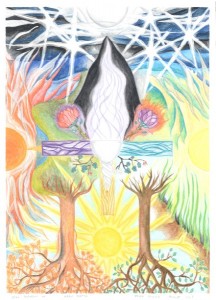 One of my favorite personal growth “formulas” was coined by a guy called Timothy W Gallway (of “The Inner Game of Tennis” fame) who said that performance = potential minus interference. What this formula points out is that as often as not is we ourselves that get in our own way at least as much if not more than anything else in our outer environment.
One of my favorite personal growth “formulas” was coined by a guy called Timothy W Gallway (of “The Inner Game of Tennis” fame) who said that performance = potential minus interference. What this formula points out is that as often as not is we ourselves that get in our own way at least as much if not more than anything else in our outer environment.
So, the first stage of getting rid of our “inner interference” is learning to create a mind of ease and relaxation. Here are seven short meditative methods for creating a mind of ease and relaxation. They can be done on their own, either as super-short practices done for as little time as 15 seconds, or they can be done in combination with each other, taking a few moments to focus on each one, and then moving onto the next. Here they are:
- Create a time for safe space – For a specific period of time consciously recognize that you are at this moment not in any manifest physical danger. Make a decision also to abstain from inner criticism of yourself, and try to feel the Earth and your immediate environment as friendly rather than hostile. Allow your mind to rest in the safe physical and psychological space of these three recognitions for the time you have set aside.
- Extend a feeling of warmth and friendliness to yourself – Chose to be a friend to yourself. Focusing on your self-sense, gently extend a feeling of warmth and welcome to it. Relax as deeply as you can into this warm feeling of liking who you are, just for now!
- Find something positive to focus on – Mentally search through the last 24 hours. Find some positive achievement, experience of good fortune, recognition of a kindness that you have given someone or other such positive event. Having found such a positive thought focus on it, developing a sense of appreciation and enjoyment for what has transpired.
- Concentrate on a single object for a short while – Take a single object such as the breathing and focus on it exclusively for a short period of time. You can temporarily forget about the causes of your stress simply by learning to focus. your mind in this way.
- Utilize the exhalation – Following on from point 4, we can combine our focused concentration with a deeper release of stress by imagining inner tension leaving our body and mind on the exhalation. There is a natural releasing or letting go mechanism that happens in our body when we breathe out that we can leverage on consciously.
- Abstain from inner criticism – Expanding a little upon point 1, we can set aside a short period of time where we decide that no critical thoughts about ourself are allowed in our mind. Discover that it is possible to shut the door on self criticism for a while, and enjoy the inner space and ease that is created! Excluding critical thoughts of others can also be included in this section.
- Be aware of the space between your thoughts – Normally we focus on the content of our consciousness, the thoughts and feelings in our mind. In doing so we become completely oblivious ever present “inner space” that is constantly there in our mind. Setting aside time to focus exclusively upon the space between our thoughts helps us to find a source of wellbeing that is there all the time but that we often overlook!
Meditation is a mind that focuses on a positive object, an object that when we focus on it makes us peaceful and happy. All of the seven points above are simple objects of meditation that, through focusing on we can begin to build our own mind of ease.
A final point, you may find that when you try to use any of the above techniques and you find your mind resisting. For example you may find that it is very difficult to develop a feeling of liking yourself when you try technique 2. If this happens then rather than struggling and trying to force yourself to get to that feeling simply be aware of your resistance to liking who you are, and take that resistance as your object of meditation. Accepting inner resistance that you encounter in meditation is one way of beginning to let go if the inner tension and blockages that are causing the resistance in the first place.



